Investigating On-Site Energy Consumption Patterns Using Vertical Electrical Sounding (VES) and Geographic Information System (GIS) Techniques
Abstract
:1. Introduction
2. Materials and Methods
2.1. Study Area
2.2. Data Collection
2.3. Data Interpretation
2.4. Pump System Sizing
2.5. Spatial Distribution Maps
3. Results and Discussion
3.1. Summary of Energy Audit
3.2. Improvement of Centrifugal(E.M)
3.3. Improvement of Centrifugal(D.E)
3.4. Improvement of Turbine(E.M)
3.5. Improvement of Turbine(D.E)
3.6. Spatial Distribution Maps of Discharge
3.7. Spatial Distribution Maps of Head
3.8. Spatial Distribution Maps of Power
3.9. Spatial Distribution Maps of Efficiency
3.10. Overlay Analysis of Centrifugal(E.M)
3.11. Overlay Analysis of Centrifugal(D.E)
3.12. Overlay Analysis of Turbine
4. Conclusions
- The comprehensive results indicated the need for the auditing of tubewell sets in an effective and efficient way to analyze the performance of the existing tubewell sets. There is a prior need for an investigation before installing a system to pump the water out from the aquifer.
- The spatial analysis proved to be helpful to decide on and recommend system requirements based on the audit of the existing tubewell sets. Based on the results, the maximum head should be kept towards the northwestern, center, and northern sides of the study area for Centrifugal(E.M), Centrifugal(D.E), and turbine, respectively.
- The efficiencies of the tubewell sets were enhanced after the post auditing phase. The overall efficiencies for Centrifugal(E.M), Centrifugal(D.E), Turbine(E.M), and Turbine(D.E) improved from 35 to 54%, 55 to 80%, 49 to 80%, and 48 to 75%, respectively.
- The auditing of the tubewell suggests that the actual head requirements and selection of the right pump size for the system result in higher discharge from the systems.
- The weighted overlay analysis for the overall efficiency of the tubewell indicated that the maximum area with a higher efficiency was observed in the northeastern side and western side of the study area for all types of tubewell arrangements. Similarly, energy saving was also observed to be higher in the northeastern side and western side of the study area after the auditing of the existing tubewell sets.
Author Contributions
Funding
Institutional Review Board Statement
Informed Consent Statement
Data Availability Statement
Acknowledgments
Conflicts of Interest
References
- Pakistan Economic Survey 2020–2021; Government of Pakistan Finance Division: Islamabad, Pakistan, 2021; Available online: https://www.pc.gov.pk/uploads/cpec/PES_2020_21.pdf (accessed on 25 September 2023).
- Hagos, F.; Makombe, G.; Namara, R.E.; Awulachew, S.B. Importance of Irrigated Agriculture to the Ethiopian Economy: Capturing the Direct Net Benefits of Irrigation; IWMI: Colombo, Sri Lanka, 2009; Volume 128. [Google Scholar]
- Tariq, M.A.U.R.; van de Giesen, N.; Janjua, S.; Shahid, M.L.U.R.; Farooq, R. An engineering perspective of water sharing issues in Pakistan. Water 2020, 12, 477. [Google Scholar] [CrossRef]
- Basharat, M. Water management in the Indus Basin in Pakistan: Challenges and opportunities. In Indus River Basin; Elsevier: Amsterdam, The Netherlands, 2019; pp. 375–388. Available online: https://www.sciencedirect.com/science/article/abs/pii/B9780128127827000175?via%3Dihub (accessed on 25 September 2023).
- Adil, S. Save the Hen who lays golden eggs. In Proceedings of the ASEAN Case Studies Workshop, Kuala Lumpur, Malaysia, 1–30 November 2007; Services and General Administration Department, Government of the Punjab: Lahore, Pakistan, 2007. [Google Scholar]
- Usman, M. Contribution of agriculture sector in the GDP growth rate of Pakistan. J. Glob. Econ. 2016, 4, 184. [Google Scholar] [CrossRef]
- Husain, I. Pakistan’s Economy and Regional Challenges. Int. Stud. 2018, 55, 253–270. [Google Scholar] [CrossRef]
- D’Odorico, P.; Carr, J.A.; Davis, K.F.; Dell’Angelo, J.; Seekell, D.A. Food inequality, injustice, and rights. Bioscience 2019, 69, 180–190. [Google Scholar] [CrossRef] [PubMed]
- Mazhar, N.; Shirazi, S.A.; Stringer, L.C.; Manzoor, S. Using UAV imagery to measure plant and water stress in winter wheat fields of drylands, south Punjab, Pakistan. Pak. J. Agric. Sci. 2021, 58, 1041–1050. [Google Scholar]
- Muzammil, M.; Zahid, A.; Breuer, L. Water resources management strategies for irrigated agriculture in the Indus Basin of Pakistan. Water 2020, 12, 1429. [Google Scholar] [CrossRef]
- Qureshi, A.S.; McCornick, P.G.; Qadir, M.; Aslam, Z. Managing salinity and waterlogging in the Indus Basin of Pakistan. Agric. Water Manag. 2008, 95, 1–10. [Google Scholar] [CrossRef]
- Adimalla, N.; Qian, H. Groundwater quality evaluation using water quality index (WQI) for drinking purposes and human health risk (HHR) assessment in an agricultural region of Nanganur, south India. Ecotoxicol. Environ. Saf. 2019, 176, 153–161. [Google Scholar] [CrossRef]
- Lanjwani, M.F.; Khuhawar, M.Y.; Jahangir Khuhawar, T.M. Assessment of groundwater quality for drinking and irrigation uses in taluka Ratodero, district Larkana, Sindh, Pakistan. Int. J. Environ. Anal. Chem. 2020, 102, 4134–4157. [Google Scholar] [CrossRef]
- Khan, N.A.; Shah, A.A.; Tariq, M.A.U.R.; Chowdhury, A.; Khanal, U. Impact of Farmers’ Climate Risk Perception and Socio-Economic Attributes on Their Choice of ICT-Based Agricultural Information Services: Empirical Evidence from Pakistan. Sustainability 2022, 14, 10196. [Google Scholar] [CrossRef]
- Qureshi, A.L.; Lashari, B.K.; Kori, S.M.; Lashari, G.A. Hydro-Salinity Behavior of Shallow Groundwater Aquifer Underlain by Salty Groundwater in Sindh Pakistan. In Proceedings of the Fifteenth International Water Technology Conference, Alexandria, Egypt, 28–30 May 2011; pp. 1–15. [Google Scholar]
- Alam, N.; Olsthoorn, T.N. Punjab Scavenger Wells for Sustainable Additional Groundwater Irrigation. Agric. Water Manag. 2014, 138, 55–67. [Google Scholar] [CrossRef]
- Zhang, D.; Sial, M.S.; Ahmad, N.; Filipe, A.J.; Thu, P.A.; Zia-Ud-Din, M.; Caleiro, A.B. Water Scarcity and Sustainability in an Emerging Economy: A Management Perspective for Future. Sustainability 2020, 13, 144. [Google Scholar] [CrossRef]
- Ahmed, W.; Sheikh, J.A.; Mahmud, M.A.P. Impact of PV System Tracking on Energy Production and Climate Change. Energies 2021, 14, 5348. [Google Scholar] [CrossRef]
- Adnan, S.; Iqbal, J.; Maltamo, M.; Bacha, M.S.; Shahab, A.; Valbuena, R. A simple approach of groundwater quality analysis, classification, and mapping in Peshawar, Pakistan. Environments 2019, 6, 123. [Google Scholar] [CrossRef]
- Militino, A.F.; Ugarte, M.D.; Perez-Goya, U.; Genton, M.G. Interpolation of the mean anomalies for cloud filling in land surface temperature and normalized difference vegetation index. IEEE Trans. Geosci. Remote Sens. 2019, 57, 6068–6078. [Google Scholar] [CrossRef]
- Raza, F.; Tamoor, M.; Miran, S.; Arif, W.; Kiren, T.; Amjad, W.; Hussain, M.I.; Lee, G.-H. The Socio-Economic Impact of Using Photovoltaic (PV) Energy for High-Efficiency Irrigation Systems: A Case Study. Energies 2022, 15, 1198. [Google Scholar] [CrossRef]
- Urfels, A.; McDonald, A.J.; Krupnik, T.J.; van Oel, P.R. Drivers of Groundwater Utilization in Water-Limited Rice Production Systems in Nepal. Water Int. 2020, 45, 39–59. [Google Scholar] [CrossRef]
- Masood, M.A. SAARC Road Map for Energy Efficiency & Energy Conservation in Pakistan; SAARC Energy Centre: Islamabad, Pakistan, 2010; Available online: https://www.saarcenergy.org/wp-content/uploads/2022/06/2012-SAARC-Action-Plan.pdf (accessed on 25 September 2023).
- Siddiqi, A.; Wescoat, J.L. Energy Use in Large-Scale Irrigated Agriculture in the Punjab Province of Pakistan. Water Int. 2013, 38, 571–586. [Google Scholar] [CrossRef]
- Asghar, S.; Sasaki, N.; Jourdain, D.; Tsusaka, T.W. Levels of Technical, Allocative, and Groundwater Use Efficiency and the Factors Affecting the Allocative Efficiency of Wheat Farmers in Pakistan. Sustainability 2018, 10, 1619. [Google Scholar] [CrossRef]
- Sarkar, A. Groundwater Irrigation and Farm Power Policies in Punjab and West Bengal: Challenges and Opportunities. Energy Policy 2020, 140, 111437. [Google Scholar] [CrossRef]
- Singh, K.; Jhorar, R.K.; Sidhpuria, M.S.; Kumar, M.; Mehla, M.K. Energy Conservation Prospects in Water Intensive Paddy-Wheat Cropping System for Groundwater Pumping in the Semi-Arid Region of Haryana. PeerJ 2023, 11, e14815. [Google Scholar] [CrossRef] [PubMed]
- Zhang, F.; Appiah, D.; Hong, F.; Zhang, J.; Yuan, S.; Adu-Poku, K.A.; Wei, X. Energy Loss Evaluation in a Side Channel Pump under Different Wrapping Angles Using Entropy Production Method. Int. Commun. Heat Mass Transf. 2020, 113, 104526. [Google Scholar] [CrossRef]
- Yang, F.; Li, Z.; Yuan, Y.; Lin, Z.; Zhou, G.; Ji, Q. Study on Vortex Flow and Pressure Fluctuation in Dustpan-Shaped Conduit of a Low Head Axial-Flow Pump as Turbine. Renew. Energy 2022, 196, 856–869. [Google Scholar] [CrossRef]
- Shahzad, H.; Farid, H.U.; Khan, Z.M.; Anjum, M.N.; Ahmad, I.; Chen, X.; Sakindar, P.; Mubeen, M.; Ahmad, M.; Gulakhmadov, A. An integrated use of GIS, geostatistical and map overlay techniques for spatio-temporal variability analysis of groundwater quality and level in the Punjab Province of Pakistan, South Asia. Water 2020, 12, 3555. [Google Scholar] [CrossRef]
- Farid, H.U.; Naeem, M.; Khan, Z.M.; Ahmad, I.; Hussain, S.; Shakoor, A.; Shahzad, H. Use of tubewell auditing and VES techniques for enhancing pumping efficiency. In Proceedings of the International Conference on Hydrology and Water Resources, Lahore, Pakistan, 25 March 2022. [Google Scholar]
- Kaliraj, S.; Chandrasekar, N.; Magesh, N.S. Evaluation of multiple environmental factors for site-specific groundwater recharge structures in the Vaigai River upper basin, Tamil Nadu, India, using GIS-based weighted overlay analysis. Environ. Earth Sci. 2015, 74, 4355–4380. [Google Scholar] [CrossRef]
- Iqbal, A.B.; Rahman, M.M.; Mondal, D.; Khandaker, N.R.; Khan, H.M.; Ahsan, G.U.; Jakariya, M.; Hossain, M.M. Assessment of Bangladesh groundwater for drinking and irrigation using weighted overlay analysis. Groundw. Sustain. Dev. 2020, 10, 100312. [Google Scholar] [CrossRef]
- Abdekareem, M.; Al-Arifi, N.; Abdalla, F.; Mansour, A.; El-Baz, F. Fusion of Remote Sensing Data Using GIS-Based AHP-Weighted Overlay Techniques for Groundwater Sustainability in Arid Regions. Sustainability 2022, 14, 7871. [Google Scholar] [CrossRef]
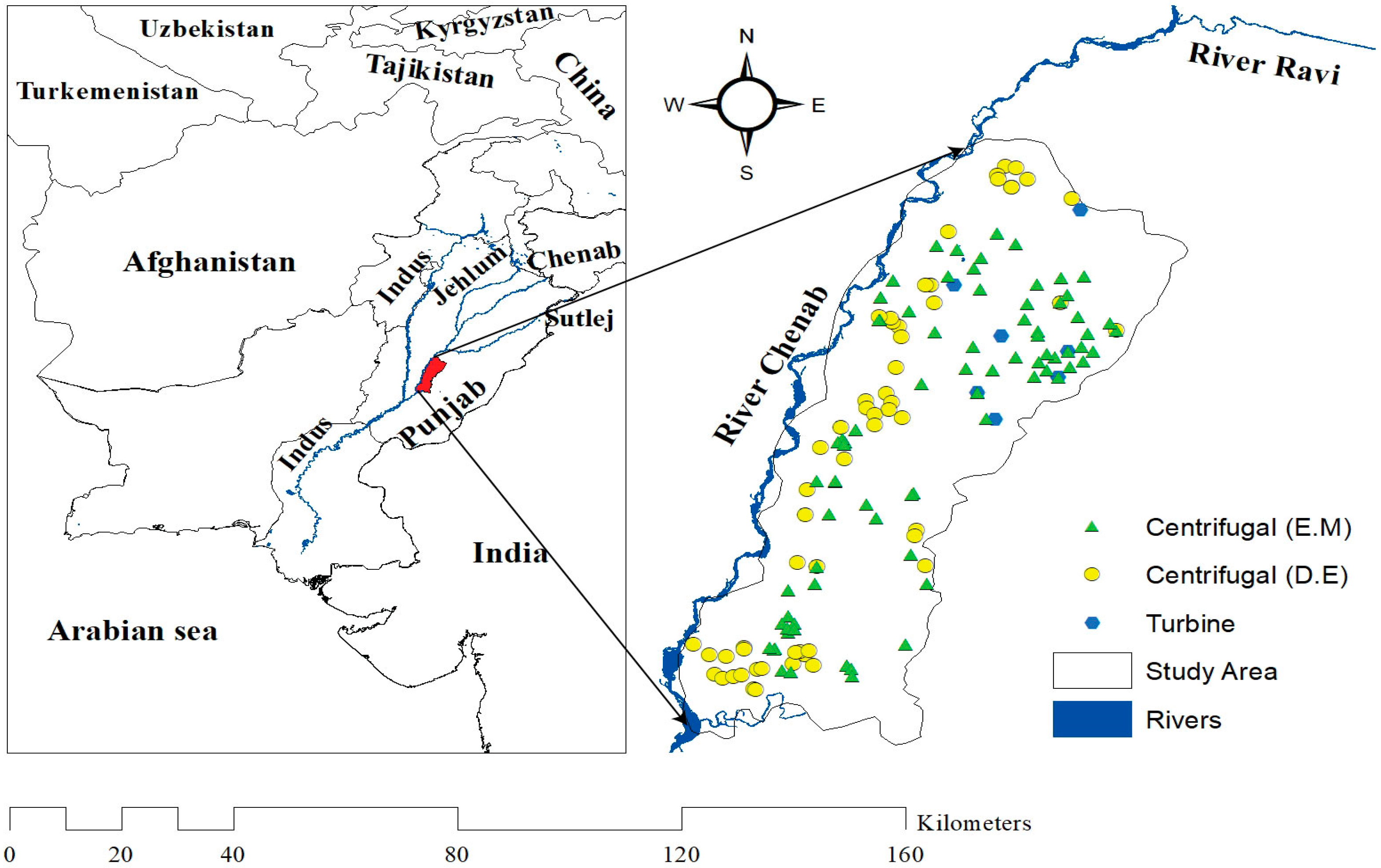


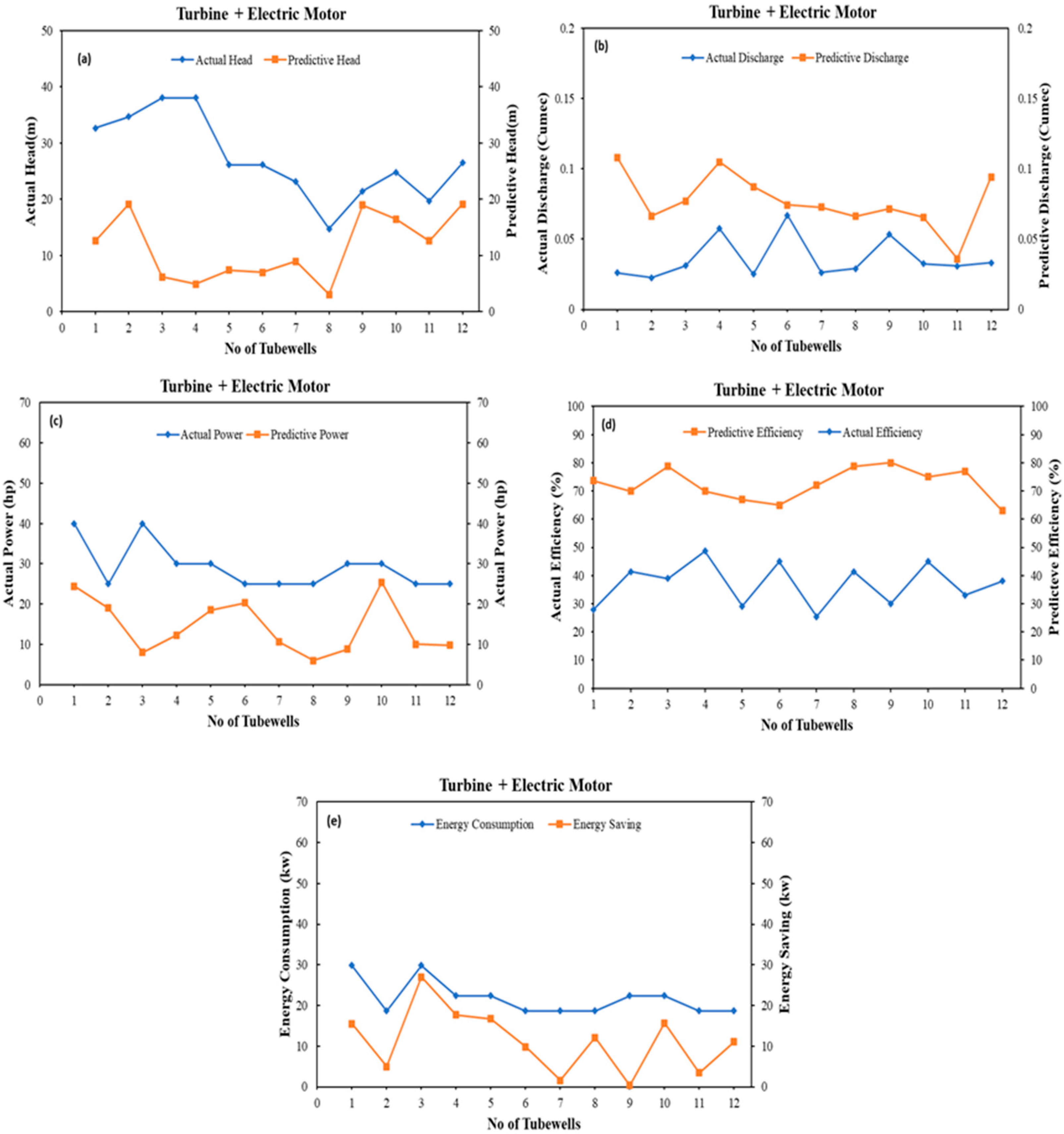


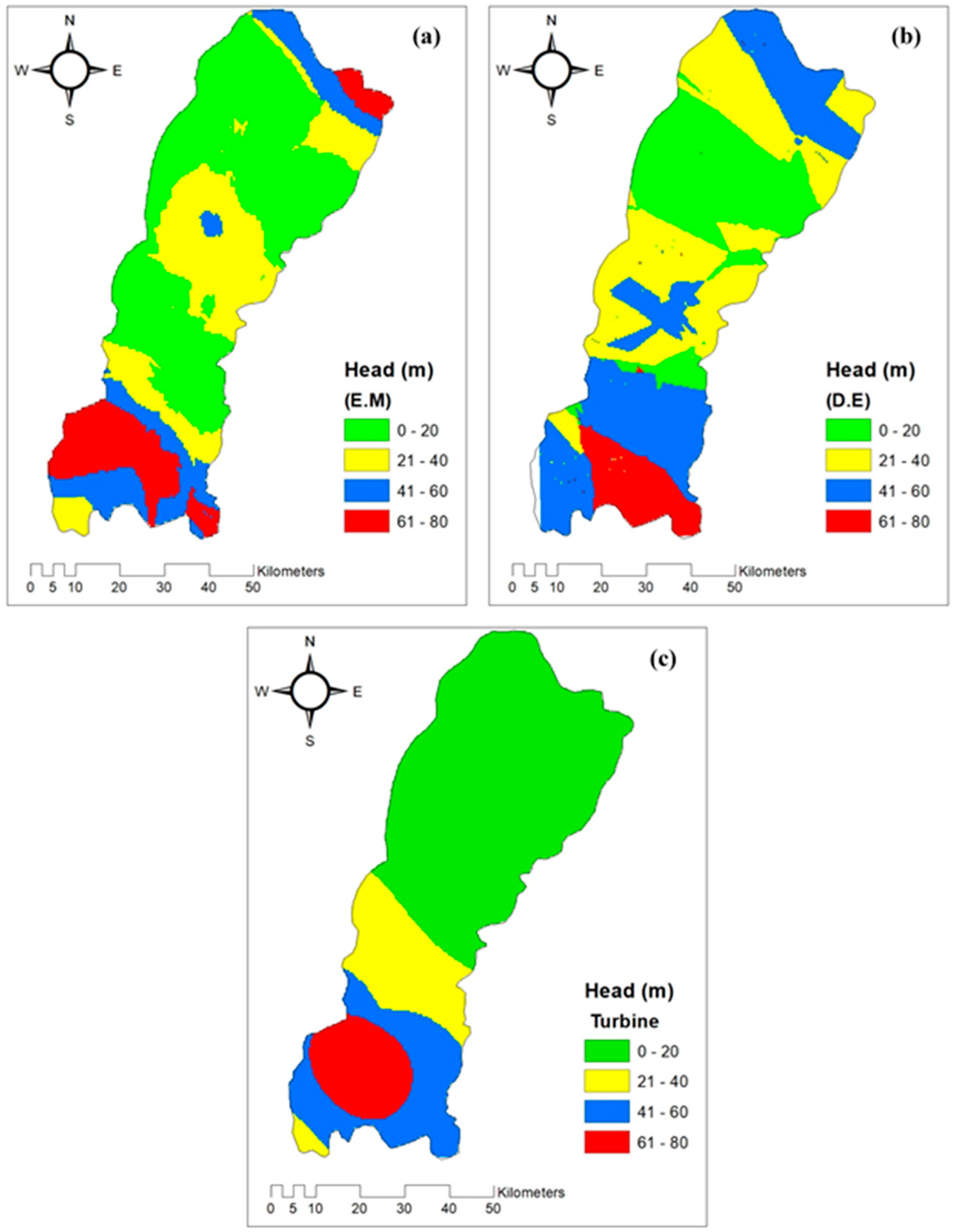
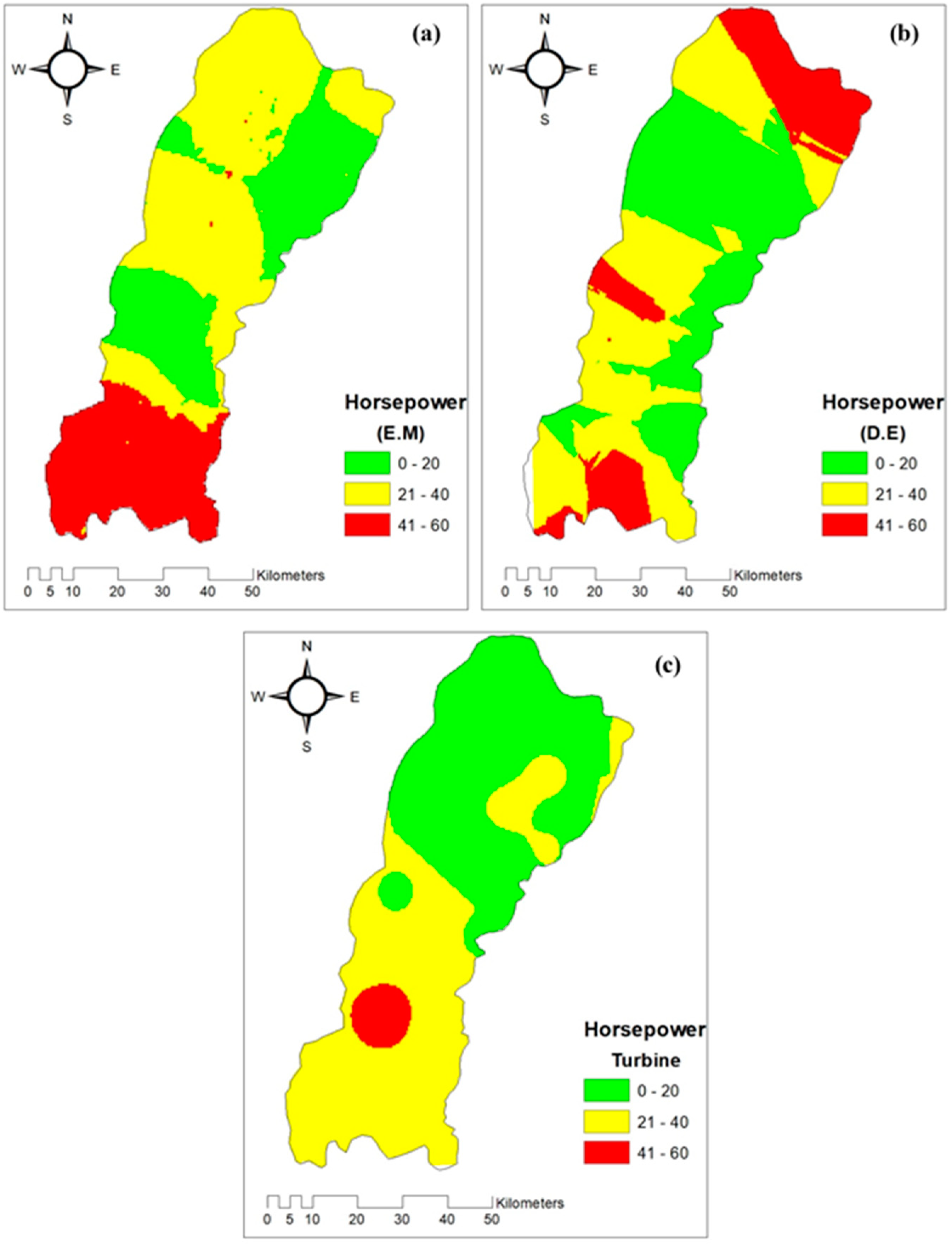
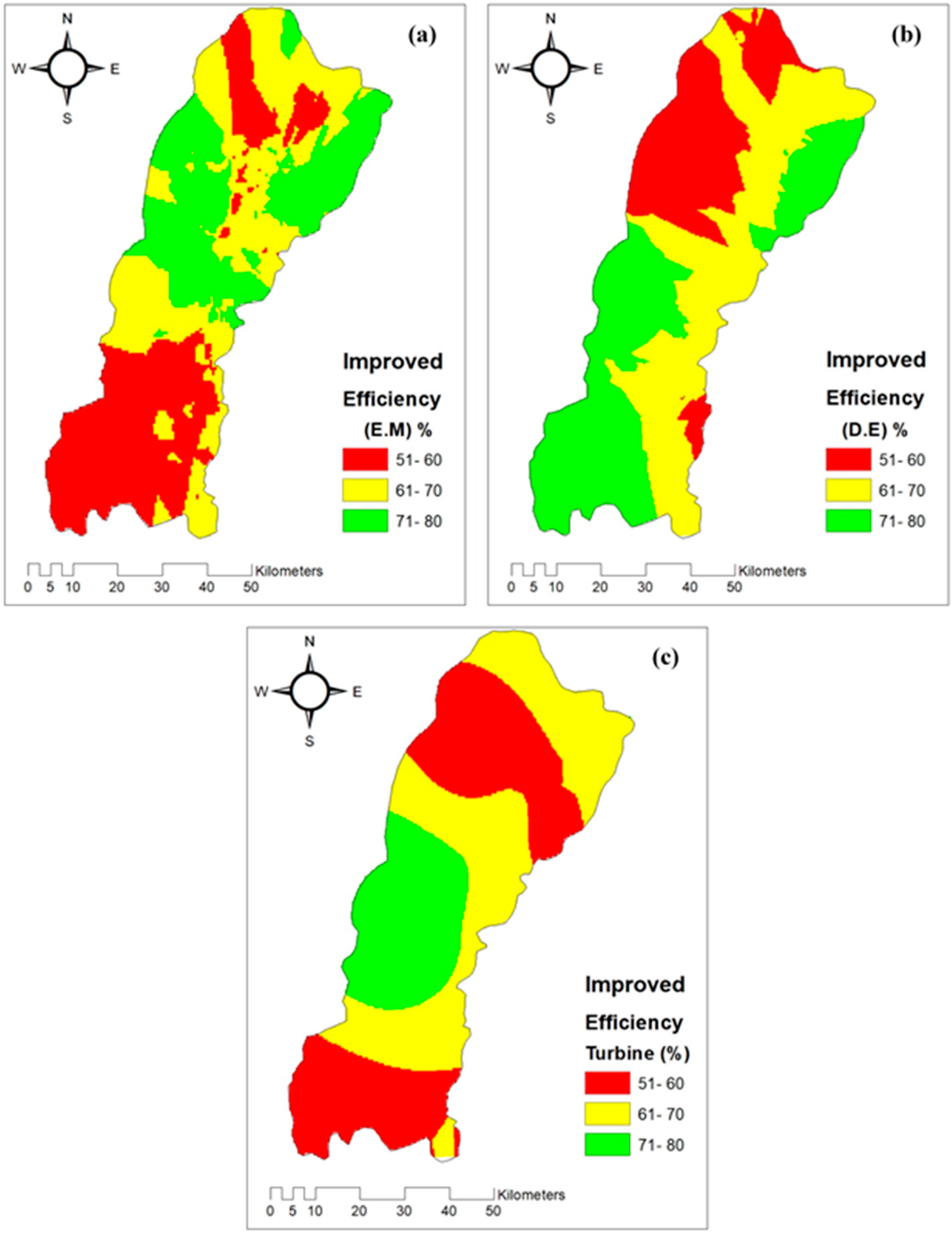
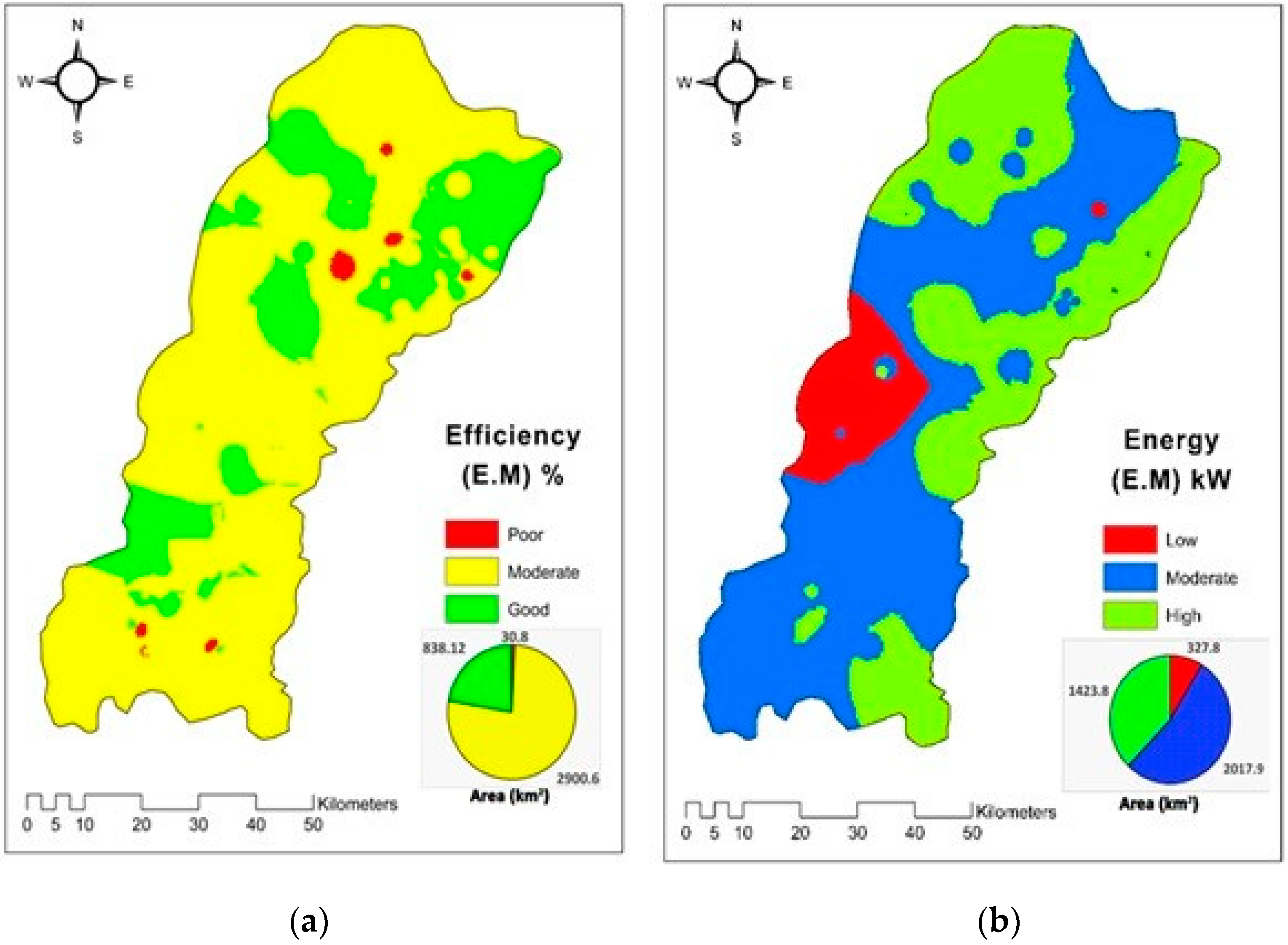
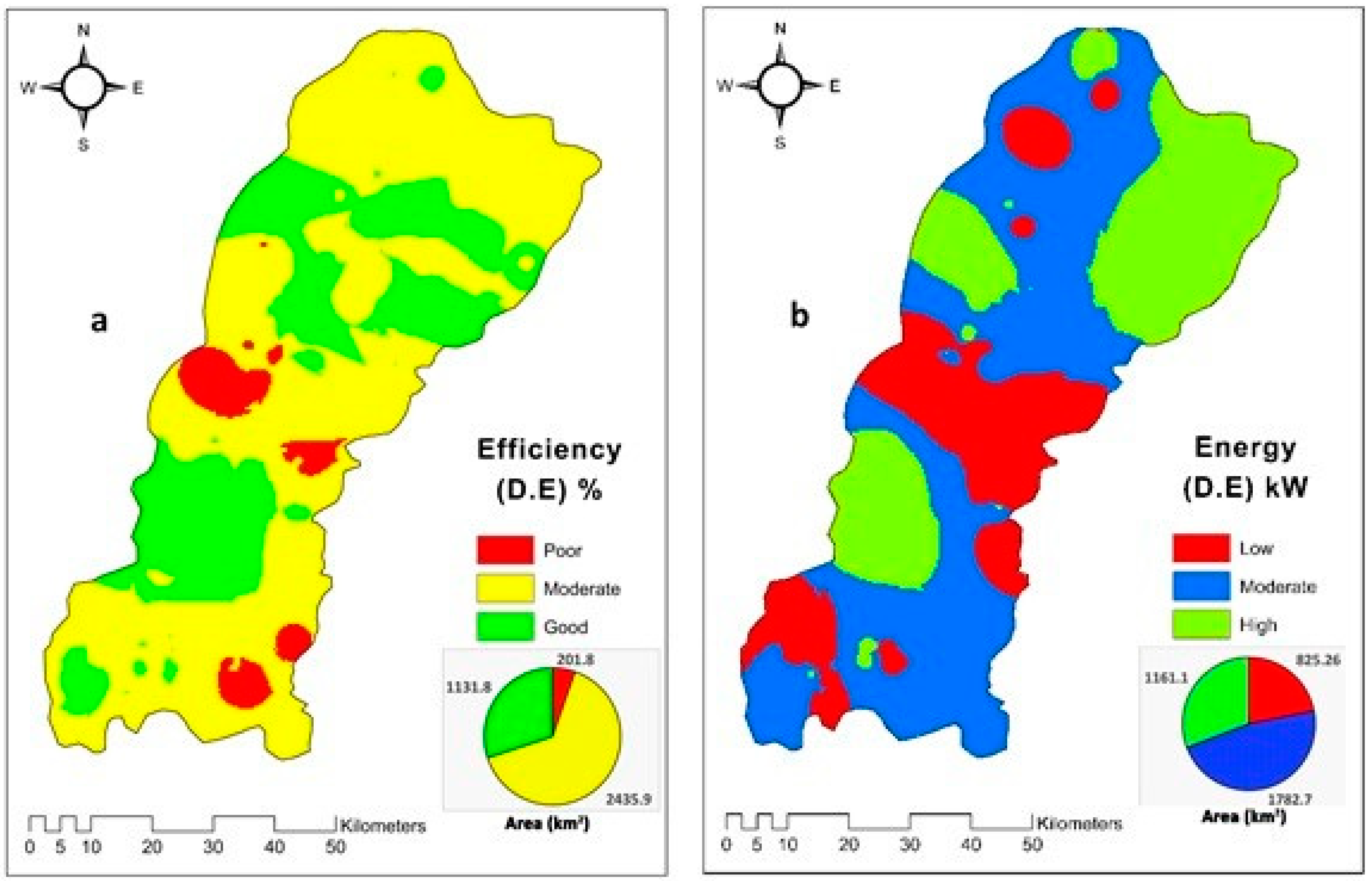

| Sr No. | Arrangement Type | No. of Installed Tubewells (N) |
|---|---|---|
| 1 | Centrifugal + Electric Motor | 106 |
| 2 | Centrifugal + Diesel Engine | 67 |
| 3 | Turbine + Electric Motor | 12 |
| 4 | Turbine + Diesel Engine | 9 |
| Parameters | Pump Arrangement | |||
|---|---|---|---|---|
| Centrifugal(E.M) | Centrifugal(D.E) | Turbine(E.M) | Turbine(D.E) | |
| HeadActual (m) | 27 | 20 | 27.19 | 34.11 |
| HeadPredicted (m) | 11.46 | 9.05 | 11.39 | 13.34 |
| H.PActual | 30 | 45 | 29 | 61 |
| H.PPredicted | 14 | 13 | 15 | 23 |
| DischargeActual (m3/s) | 0.028 | 0.029 | 0.036 | 0.038 |
| DischargePredicted (m3/s) | 0.067 | 0.079 | 0.077 | 0.080 |
| EfficiencyActual (%) | 22.37 | 48.11 | 36.97 | 50.93 |
| EfficiencyPredicted (%) | 45 | 69.23 | 73 | 66.05 |
| No. of Tubewells (N) | 106 | 67 | 12 | 9 |
Disclaimer/Publisher’s Note: The statements, opinions and data contained in all publications are solely those of the individual author(s) and contributor(s) and not of MDPI and/or the editor(s). MDPI and/or the editor(s) disclaim responsibility for any injury to people or property resulting from any ideas, methods, instructions or products referred to in the content. |
© 2023 by the authors. Licensee MDPI, Basel, Switzerland. This article is an open access article distributed under the terms and conditions of the Creative Commons Attribution (CC BY) license (https://creativecommons.org/licenses/by/4.0/).
Share and Cite
Abdullah, H.; Farid, H.U.; Naeem, M.; Zubair, N.; Khan, Z.M.; Shahzad, H.; Sikandar, P.; Abrar, M.; Shakoor, A.; Mubeen, M. Investigating On-Site Energy Consumption Patterns Using Vertical Electrical Sounding (VES) and Geographic Information System (GIS) Techniques. Sustainability 2023, 15, 16782. https://doi.org/10.3390/su152416782
Abdullah H, Farid HU, Naeem M, Zubair N, Khan ZM, Shahzad H, Sikandar P, Abrar M, Shakoor A, Mubeen M. Investigating On-Site Energy Consumption Patterns Using Vertical Electrical Sounding (VES) and Geographic Information System (GIS) Techniques. Sustainability. 2023; 15(24):16782. https://doi.org/10.3390/su152416782
Chicago/Turabian StyleAbdullah, Haris, Hafiz Umar Farid, Maira Naeem, Nadeem Zubair, Zahid Mahmood Khan, Huzaifa Shahzad, Pervaiz Sikandar, Muhammad Abrar, Aamir Shakoor, and Muhammad Mubeen. 2023. "Investigating On-Site Energy Consumption Patterns Using Vertical Electrical Sounding (VES) and Geographic Information System (GIS) Techniques" Sustainability 15, no. 24: 16782. https://doi.org/10.3390/su152416782
APA StyleAbdullah, H., Farid, H. U., Naeem, M., Zubair, N., Khan, Z. M., Shahzad, H., Sikandar, P., Abrar, M., Shakoor, A., & Mubeen, M. (2023). Investigating On-Site Energy Consumption Patterns Using Vertical Electrical Sounding (VES) and Geographic Information System (GIS) Techniques. Sustainability, 15(24), 16782. https://doi.org/10.3390/su152416782






